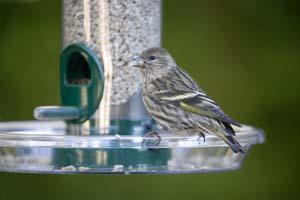
Bird of the Month: Pine Siskin
PIne Siskins are small songbirds with sharp, pointed bills and short, notched tails. They are brown and very streaky with subtle yellow edging on the wings and tail. Pine Siskins are highly nomadic and may inundate your thistle feeder one year and be totally absent the next. You may see these little acrobats clinging to the branch tips of pine trees or other conifers. They forage for food in tight flocks and twitter incessantly to each other even in flight.
Other fun facts about these entertaining songbirds:
Pine Siskins become considerably plumper through accumulation of fat with the onset of winter. Each bird can pack enough seeds into its expandable esophagus to support itself through five hours of rest at –4º F temperatures. During cold nights, they can accelerate their metabolic rate up to 5 times more than normal to keep warm.
Pine Siskins have difficulty opening the large seeds of striped sunflower but enjoy hulled sunflower seed, chips and Nyjer.
A siskin may take up a position near an Evening Grosbeak that is eating larger seeds like striped sunflower to pick up dropped particles and will even defend the position against other siskins.
Pine Siskins may nest in loose colonies and will tolerate the occasional visit to one another's nests after their young are hatched.
The Pine Siskin is the most common of the "winter finches" to be found at your feeders…but not every year. An “irruption” migration usually takes place every two or three years that can bring large numbers of Siskins to your backyard. A failed seed crop in the boreal forest is the usual cause of this.
Some “irruptive” Siskins may stay near a dependable food source and nest far south of their normal breeding range.
The primary natural foods of Pine Siskins are the seeds of hemlocks, alders, birches, and cedars.
Pine Siskins, like most northern finches, are fond of salt. They seek out natural salt licks and in the winter they can be found along highways eating the salt used to melt ice and snow.
Siskins, crossbills and other finches have been observed eating flaking mortar as a source of sodium and calcium.
Pine Siskins are particularly susceptible to salmonella disease which is spread by fecal contamination of food or water. Sick birds may appear lethargic, puffed up, thin and may have swollen eyelids. If you detect a sick bird at your feeder, empty it, discard the food and disinfect the feeder with a solution of 9 parts water and 1 part bleach (do not use this solution on wooden feeders). Soak the feeder for 10 minutes, rinse thoroughly and let it dry completely before refilling it. Clean up any food debris that is on the ground and put it in the trash. Clean the feeder with the bleach solution every two weeks as a preventative measure.

